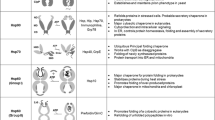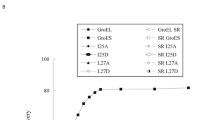Abstract
The bacterial chaperonins are highly sophisticated molecular nanomachines, controlled by the hydrolysis of ATP to dynamically trap and remove from the environment unstable protein molecules that are susceptible to denaturation and aggregation. Chaperonins also act to assist in the refolding of these unstable proteins, providing a means by which these proteins may return in active form to the complex environment of the cell. The Escherichia coli GroE chaperonin system is one of the largest protein supramolecular complexes known, whose quaternary structure is required for segregating aggregation-prone proteins. Over the course of more than two decades of research on GroE, it has become accepted that GroE, more specifically the GroEL subunit, is a “high-tolerance” molecular system, capable of accommodating numerous mutations, while retaining its molecular integrity. In some cases, a given site of mutation was revealed to be absolutely required for GroEL function, providing hints regarding the network of signals and triggers that propel this unique system. In other instances, however, a mutation has produced a more delicate response, altering only part of, or in some cases, only a single facet of, the molecular mechanism, and these mutants have often provided invaluable hints on the extent of the complexity underlying chaperonin-assisted protein folding. In this review, we highlight some examples of the latter type of GroEL mutants which compose the unique “mutational repertoire” of GroEL and touch upon the important clues that each mutant provided to the overall effort to elucidate the details of GroE action.



Similar content being viewed by others
References
Aharoni A, Horovitz A (1996) Inter-ring communication is disrupted in the GroEL mutant Arg13 → Gly; Ala126 → Val with known crystal structure. J Mol Biol 258:732–735. https://doi.org/10.1006/jmbi.1996.0282
Altamirano MM, Golbik R, Zahn R, Buckle AM, Fersht AR (1997) Refolding chromatography with immobilized mini-chaperones. Proc Natl Acad Sci U S A 94:3576–3578
Altamirano MM, García C, Possani LD, Fersht AR (1999) Oxidative refolding chromatography: folding of the scorpion toxin Cn5. Nat Biotechnol 17:187–191. https://doi.org/10.1038/6192
Braig K, Otwinowski Z, Hegde R, Boisvert DC, Joachimiak A, Horwich AL, Sigler PB (1994) The crystal structure of the bacterial chaperonin GroEL at 2.8 Å. Nature 371:578–586
Chatellier J, Hill F, Lund PA, Fersht AR (1998) In vivo activities of GroEL minichaperones. Proc Natl Acad Sci U S A 95:9861–9866
Chaudhry C, Horwich AL, Brunger AT, Adams PD (2004) Exploring the structural dynamics of the E. coli chaperonin GroEL using translation–libration–screw crystallographic refinement of intermediate states. J Mol Biol 342:229–245
Clare DK, Vasishtan D, Stagg S, Quispe J, Farr GW, Topf M, Horwich AL, Saibil HR (2012) ATP-triggered conformational changes delineate substrate-binding and -folding mechanics of the GroEL chaperonin. Cell 149:113–123. https://doi.org/10.1016/j.cell.2012.02.047
Danziger O, Rivenzon-Segal D, Wolf SG, Horovitz A (2003) Conversion of the allosteric transition of GroEL from concerted to sequential by the single mutation Asp-155 → Ala. Proc Natl Acad Sci U S A 100:13797–13802. https://doi.org/10.1073/pnas.2333925100
Elad N, Farr GW, Clare DK, Orlova EV, Horwich AL, Saibil HR (2007) Topologies of a substrate protein bound to the chaperonin GroEL. Mol Cell 26:415–426
Farr GW, Furtak K, Rowland MB, Ranson NA, Saibil HR, Kirchhausen T, Horwich AL (2000) Multivalent binding of nonnative substrate proteins by the chaperonin GroEL. Cell 100:561–573
Fenton WA, Kashi Y, Furtak K, Horwich AL (1994) Residues in chaperonin GroEL required for polypeptide binding and release. Nature 371:614–619
Fukui N, Araki K, Hongo K, Mizobata T, Kawata Y (2016) Modulating the effects of the bacterial chaperonin GroEL on fibrillogenic polypeptides through modification of domain hinge architecture. J Biol Chem 291:25217–25226. https://doi.org/10.1074/jbc.M116.751925
Georgopoulos CP, Hendrix RW, Kaiser AD, Wood WB (1972) Role of the host cell in bacteriophage morphogenesis: effects of a bacterial mutation on T4 head assembly. Nat New Biol 239:38–41
Gruber R, Horovitz A (2016) Allosteric mechanisms in chaperonin machines. Chem Rev 116:6588–6606. https://doi.org/10.1021/acs.chemrev.5b00556
Hartl FU, Bracher A, Hayer-Hartl M (2011) Molecular chaperones in protein folding and proteostasis. Nature 475:324–332. https://doi.org/10.1038/nature10317
Hayer-Hartl M, Bracher A, Hartl FU (2016) The GroEL–GroES chaperonin machine: a nano-cage for protein folding. Trends Biochem Sci 41:62–76. https://doi.org/10.1016/j.tibs.2015.07.009
Heinemann U, Hahn M (1995) Circular permutation of polypeptide chains: implications for protein folding and stability. Prog Biophys Mol Biol 64:121–143
Iizuka R, Funatsu T (2016) Chaperonin GroEL uses asymmetric and symmetric reaction cycles in response to the concentration of non-native substrate proteins. Biophys Physicobiol 13:63–69. https://doi.org/10.2142/biophysico.13.0_63
Kawata Y, Kawagoe M, Hongo K, Miyazaki T, Higurashi T, Mizobata T, Nagai J (1999) Functional communications between the apical and equatorial domains of GroEL through the intermediate domain. Biochemistry 38:15731–15740
Kawe M, Plückthun A (2006) GroEL walks the fine line: the subtle balance of substrate and co-chaperonin binding by GroEL. A combinatorial investigation by design, selection and screening. J Mol Biol 357:411–426
Kim S, Willison KR, Horwich AL (1994) Cystosolic chaperonin subunits have a conserved ATPase domain but diverged polypeptide-binding domains. Trends Biochem Sci 19:543–548
Kim YE, Hipp MS, Bracher A, Hayer-Hartl M, Hartl FU (2013) Molecular chaperone functions in protein folding and proteostasis. Annu Rev Biochem 82:323–355. https://doi.org/10.1146/annurev-biochem-060208-092442
Machida K, Fujiwara R, Tanaka T, Sakane I, Hongo K, Mizobata T, Kawata Y (2009) Gly192 at hinge 2 site in the chaperonin GroEL plays a pivotal role in the dynamic apical domain movement that leads to GroES binding and efficient encapsulation of substrate proteins. Biochim Biophys Acta 1794:1344–1354. https://doi.org/10.1016/j.bbapap.2008.12.003
Martin J (1998) Role of the GroEL chaperonin intermediate domain in coupling ATP hydrolysis to polypeptide release. J Biol Chem 273:7351–7357
Mayhew M, da Silva AC, Martin J, Erdjument-Bromage H, Tempst P, Hartl FU (1996) Protein folding in the central cavity of the GroEL–GroES chaperonin complex. Nature 379:420–426
Miyazaki T, Yoshimi T, Furutsu Y, Hongo K, Mizobata T, Kanemori M, Kawata Y (2002) GroEL–substrate–GroES ternary complexes are an important transient intermediate of the chaperonin cycle. J Biol Chem 277:50621–50628. https://doi.org/10.1074/jbc.M209183200
Mizobata T, Uemura T, Isaji K, Hirayama T, Hongo K, Kawata Y (2011) Probing the functional mechanism of Escherichia coli GroEL using circular permutation. PLoS One 6:e26462. https://doi.org/10.1371/journal.pone.0026462
Mizuta T, Ando K, Uemura T, Kawata Y, Mizobata T (2013) Probing the dynamic process of encapsulation in Escherichia coli GroEL. PLoS One 8:e78135. https://doi.org/10.1371/journal.pone.0078135
Motojima F, Chaudhry C, Fenton WA, Farr GW, Horwich AL (2004) Substrate polypeptide presents a load on the apical domains of the chaperonin GroEL. Proc Natl Acad Sci U S A 101:15005–15012
Ojha B, Fukui N, Hongo K, Mizobata T, Kawata Y (2016) Suppression of amyloid fibrils using the GroEL apical domain. Sci Rep 6:31041. https://doi.org/10.1038/srep31041
Pettersen EF, Goddard TD, Huang CC, Couch GS, Greenblatt DM, Meng EC, Ferrin TE (2004) UCSF Chimera—a visualization system for exploratory research and analysis. J Comput Chem 25:1605–1612. https://doi.org/10.1002/jcc.20084
Piggot TJ, Sessions RB, Burston SG (2012) Toward a detailed description of the pathways of allosteric communication in the GroEL chaperonin through atomistic simulation. Biochemistry 51:1707–1718. https://doi.org/10.1021/bi201237a
Ranson NA, Clare DK, Farr GW, Houldershaw D, Horwich AL, Saibil HR (2006) Allosteric signaling of ATP hydrolysis in GroEL–GroES complexes. Nat Struct Mol Biol 13:147–152
Rye HS, Burston SG, Fenton WA, Beechem JM, Xu Z, Sigler PB, Horwich AL (1997) Distinct actions of cis and trans ATP within the double ring of the chaperonin GroEL. Nature 388:792–798
Rye HS, Roseman AM, Chen S, Furtak K, Fenton WA, Saibil HR, Horwich AL (1999) GroEL–GroES cycling: ATP and nonnative polypeptide direct alternation of folding-active rings. Cell 97:325–338
Saibil HR, Fenton WA, Clare DK, Horwich AL (2013) Structure and allostery of the chaperonin GroEL. J Mol Biol 425:1476–1487. https://doi.org/10.1016/j.jmb.2012.11.028
Sharapova OA, Yurkova MS, Fedorov AN (2016) A minichaperone-based fusion system for producing insoluble proteins in soluble stable forms. Protein Eng Des Sel 29:57–64. https://doi.org/10.1093/protein/gzv060
Takano T, Kakefuda T (1972) Involvement of a bacterial factor in morphogenesis of bacteriophage capsid. Nat New Biol 239:34–37
Viitanen PV, Lubben TH, Reed J, Goloubinoff P, O’Keefe DP, Lorimer GH (1990) Chaperonin-facilitated refolding of ribulose bisphosphate carboxylase and ATP hydrolysis by chaperonin 60 (groEL) are potassium dependent. Biochemistry 29:5665–5671
Wang Q, Buckle AM, Fersht AR (2000) Stabilization of GroEL minichaperones by core and surface mutations. J Mol Biol 298:917–926
Wang JD, Herman C, Tipton KA, Gross CA, Weissman JS (2002) Directed evolution of substrate-optimized GroEL/S chaperonins. Cell 111:1027–1039
Weissman JS, Hohl CM, Kovalenko O, Kashi Y, Chen S, Braig K, Saibil HR, Fenton WA, Horwich AL (1995) Mechanism of GroEL action: productive release of polypeptide from a sequestered position under GroES. Cell 83:577–587
Weissman JS, Rye HS, Fenton WA, Beechem JM, Horwich AL (1996) Characterization of the active intermediate of a GroEL–GroES-mediated protein folding reaction. Cell 84:481–490
Williams TA, Fares MA (2010) The effect of chaperonin buffering on protein evolution. Genome Biol Evol 2:609–619. https://doi.org/10.1093/gbe/evq045
Xu Z, Horwich AL, Sigler PB (1997) The crystal structure of the asymmetric GroEL–GroES–(ADP)7 chaperonin complex. Nature 388:741–750
Yamamoto D, Ando T (2016) Chaperonin GroEL–GroES functions as both alternating and non-alternating engines. J Mol Biol 428:3090–3101. https://doi.org/10.1016/j.jmb.2016.06.017
Yébenes H, Mesa P, Muñoz IG, Montoya G, Valpuesta JM (2011) Chaperonins: two rings for folding. Trends Biochem Sci 36:424–432. https://doi.org/10.1016/j.tibs.2011.05.003
Yifrach O, Horovitz A (1994) Two lines of allosteric communication in the oligomeric chaperonin GroEL are revealed by the single mutation Arg196→Ala. J Mol Biol 243:397–401. https://doi.org/10.1006/jmbi.1994.1667
Yifrach O, Horovitz A (1995) Nested cooperativity in the ATPase activity of the oligomeric chaperonin GroEL. Biochemistry 34:5303–5308
Zahn R, Buckle AM, Perrett S, Johnson CM, Corrales FJ, Golbik R, Fersht AR (1996) Chaperone activity and structure of monomeric polypeptide binding domains of GroEL. Proc Natl Acad Sci U S A 93:15024–15029
Funding
Portions of the manuscript performed by the authors was funded by a Grant-in-Aid for Scientific Research (C) (no. 22570119 to T. M.) from the Japan Society for the Promotion of Science (JSPS) and by the Strategic Research Program for Brain Sciences from the Japan Agency for Medical Research and Development (AMED).
Author information
Authors and Affiliations
Corresponding authors
Ethics declarations
Conflict of interest
Tomohiro Mizobata declares that he has no conflict of interest. Yasushi Kawata declares that he has no conflict of interest.
Ethical approval
This article does not contain any studies with human participants or animals performed by any of the authors.
Additional information
This article is part of a Special Issue on ‘Biomolecules to Bio-nanomachines - Fumio Arisaka 70th Birthday’ edited by Damien Hall, Junichi Takagi and Haruki Nakamura.
Rights and permissions
About this article
Cite this article
Mizobata, T., Kawata, Y. The versatile mutational “repertoire” of Escherichia coli GroEL, a multidomain chaperonin nanomachine. Biophys Rev 10, 631–640 (2018). https://doi.org/10.1007/s12551-017-0332-0
Received:
Accepted:
Published:
Issue Date:
DOI: https://doi.org/10.1007/s12551-017-0332-0




